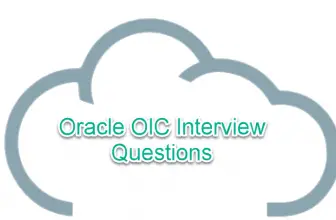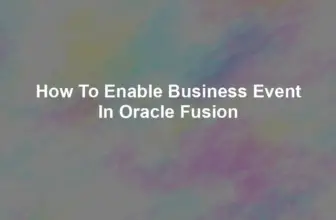45+ Super Technical Oracle Fusion Interview Questions

Oracle Fusion has been around for 10+ years now and is a very mature product from oracle. Lots of Enterprises big and small are shifting toward Oracle Fusion which is available both as OnPremise and SaaS. Fusion Apps tech skills are critical for all EBS Apps tech resources working on Fusion SaaS.
Let’s look at some of the top Oracle Fusion interview questions which can help you for your oracle fusion interviews.
FAQs :Oracle Fusion Interview Questions
Oracle Fusion has a complete suite of products to mange enterprise business in vertical HCM , ERP , SCM ,CX. It has some of the best features of on prem products like PeopleSoft, EBS, Siebel.
Please refer below diagram
source: https://docs.oracle.com/cd/E51367_01/fa_lcm_gs/OAINS/tplgydir.htm#OAINS2035
ESS Jos are Oracle Enterprise Scheduler Service Jobs like concurrent programs of EBS which can be run and scheduled to run a business process.
Go to Functional Setup manager
Query task manage Enterprise Scheduler Job Definitions %
Search for the ESS Job Name
Edit or view to see the details like job name and parameters
Go to Tools > Scheduled process > Schedule New Process( Button)
Page composer is a configuration feature by which we can do some basic configuration like add a field , menu entry etc . Activate Sandbox go to Content area > Edit Html and add your custom element.
Tools >Structure> Navigate to the menu > Add menu item Select option to show in springboard
Expression builder is used to write conditional expressions based on value of the VO objects on page.
Modification are stored in MDS (Meta data repository)
Yes.
Delete the Published XMLs from the sandbox and re publish the sandbox
In the custom menu configuration, there is an option to check the security context with the user role.
Activate sandbox
Go to the section where URL link to be added
go to its parent task flow
edit the config of the link
go to expression builder and set target which is your link and binding parameter of the page attribute
We can create a link with target base URL and add query strings like ?
the fusion vo field value can be accessed by #bindings.attritbutename.value
eg #{bindings.NumberAttr04.inputValue}
Example of a link can be https://google.com/search/?q=#{bindings.NumberAttr04.inputValue}
If you get null in the binding means its not able to access the field value, try another taskflow level.
You can't do these activities with page composer
Change either the data or functional security for a page. While you can hide some components, you must change the security setup to control access.
Filter or reorder lists of values.
Add any code, validation logic, or scripting to the buttons or fields.
Add call-outs to other APIs to populate fields with values.
Change the selections that appear in the Navigator menu.
At the high level, page composer is available across all pillars of fusion saas while application composer is only for CRM and very limited for ERP pillar.
With App composer, we can create a custom object to store data, not with page composer.
Refer to this Oracle documentation for more details.
Pass the previlege internal name in #{securityContext.userGrantedPermission['privilege']}
eg #{securityContext.userGrantedPermission['MANAGER_REPORTS_LINK_PRIV']}
In source view, you can see all the elements of page in a tree structure which can be configured
In design view the layout is visible and properties can be configured
In Design view, drag and drop the component
In Source view, do any of the following:
Cut and paste the component
Drag and drop the component
Open the Component Properties for the container component and rearrange the components on the Child Components tab
No, some elements are locked. For some edit component is disabled.
global page template provides a common header area and the footer panel for all pages in your application. You can use Page Composer to configure the global page template
Infolets are feed layouts with small area . It can be configured with it link in corner and BIP URL can be added.
You can enable them by using the Home Configuration tab in the Structure work area
Tools > Security Console> create role > add privilege > query user > Edit and add role
Abstract , job role and duty role
FND - Application Role which inherits ORA role . Can be customized
ORA- Seeded Role , can only be copied not customized .
Job Retrieve Lates LDAP changes. This can be run manually also to quicken the process of role addition.
A Duty Role grants access to privileges required to complete a specific task, or a set of related tasks.
A Job role combines duty roles required to grant access to a broad range of tasks.
You can assign job roles to users. In combination, the job roles assigned to a person encompass all that he or she is hired to do.
You cannot assign duty roles directly to users. A User is granted duty role indirectly as components of job roles.
Navigator > tools > Page integration wizard you can add a URL that will be embedded
DFF: To Capture additional information. It is stored in tables as attributes
EFF: Establish one-to-many data relationships and make application data context-sensitive. The flexfields appear only when the contextual data conditions are fulfilled. Thus, extensible flexfields provide more flexibility than descriptive flexfields.
Configure flexfield segments.
Use task Manage Extensible Flexfields or Manage Descriptive Flexfields , or use the Configure Flexfield icon button directly on the page where the flexfield is highlighted.
For simple configurations, use the Add Segment, Add Context Value, and Edit Segment icon buttons directly on the page where the flexfield is highlighted.
Finally validate and Deploy the flexfield.
On the page Go to Administration > Highlight flexfields >It will show all the flexfields > Click Configure
API name is the element name used for integrations. Changing API name after an integration is activated can break the integration.
You can use these bind variables in the WHERE clause of the SQL statement.:{SEGMENT.<segment_code>}: Identifies a segment in the same context.:{PARAMETER.<parameter_code>}: Identifies a parameter.:{CONTEXT.<context_code>;SEGMENT.<segment_code>}: Identifies a segment in a different context. The context must be in the same category or in an ancestor category, and it can't be a multiple-row context.:{VALUESET.<value_set_code>}: Identifies the closest prior segment in the same context that's assigned to the specified value set.:{FLEXFIELD.<internal_code>}: Identifies a flexfield
As many as we want. No Limit
Deep links are useful if you have a non-fusion page and you want users to go directly from there to Oracle Applications Cloud. For example, you can enable direct navigation to the My Team page. To see a complete list of the available deep links, use the Deep Links work area (Navigator > Tools > Deep Links). For access to this work area, you need to have the View Administration Link (FND_VIEW_ADMIN_LINK_PRIV) privilege
The approval engine of fusion is BPM. Business process automation. BPM Task of a process has to be modified as per approval requirement.
When a transaction is done is fusion you can go to Tools > Transaction Console, Find your transaction click on Actions > Download logs. You have an entry of Approval Task at the end.
Fusion provides different to interact with its apps like
FBDI - When you have data in the flat file to be loaded
Webservices (SOAP and Rest) - For real-time integrations
Business Events - For outbound integrations
UCM (Universal Content Management) is the door for entry to fusion. Files can be uploaded there via services and processed by ESS jobs.
Attachments are stored in UCM. There are web services by which they can be accessed.
Groovy scripting is used for writing code in extension and validations. Widely used in Appcomposer.
We can use PaaS Process Cloud to extend a business process customization and approvals.
Order orchestration is used to do order processing. Events are defined as Tasks and for each task, the behavior can be defined. Common tasks are Scheduling, Reservation, Transportation, Billing etc.
CSF Key has the credentials to call external process (like OIC / SOA)
Connectors are defined in FSM task Manage external web service details. Each connector will have the endpoint URL with user / PWD. and triggering options like Asynchronous, synchronous, business event.
Suggested Readings for interviews on Apps Tech:









